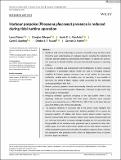Files in this item
Harbour porpoise (Phocoena phocoena) presence is reduced during tidal turbine operation
Item metadata
| dc.contributor.author | Palmer, Laura E. | |
| dc.contributor.author | Gillespie, Douglas M. | |
| dc.contributor.author | MacAulay, Jamie D. J. | |
| dc.contributor.author | Sparling, Carol E. | |
| dc.contributor.author | Russell, Debbie JF | |
| dc.contributor.author | Hastie, Gordon D. | |
| dc.date.accessioned | 2021-11-08T10:30:16Z | |
| dc.date.available | 2021-11-08T10:30:16Z | |
| dc.date.issued | 2021-12 | |
| dc.identifier | 276052976 | |
| dc.identifier | 4e8ded00-6d28-42cc-b098-a8cb2a3a9c08 | |
| dc.identifier | 85118502561 | |
| dc.identifier | 000714943800001 | |
| dc.identifier.citation | Palmer , L E , Gillespie , D M , MacAulay , J D J , Sparling , C E , Russell , D JF & Hastie , G D 2021 , ' Harbour porpoise ( Phocoena phocoena ) presence is reduced during tidal turbine operation ' , Aquatic Conservation: Marine and Freshwater Ecosystems , vol. 31 , no. 12 , pp. 3543-3553 . https://doi.org/10.1002/aqc.3737 | en |
| dc.identifier.issn | 1052-7613 | |
| dc.identifier.other | ORCID: /0000-0001-7658-5111/work/103137318 | |
| dc.identifier.other | ORCID: /0000-0002-1969-102X/work/103137371 | |
| dc.identifier.other | ORCID: /0000-0001-9628-157X/work/103137404 | |
| dc.identifier.other | ORCID: /0000-0002-9773-2755/work/103137706 | |
| dc.identifier.uri | https://hdl.handle.net/10023/24276 | |
| dc.description | Funding: Scottish Government (GrantNumber(s): MMSS/002/15), Natural Environment Research Council (GrantNumber(s): NE/R015007/1). | en |
| dc.description.abstract | 1. Uptake of tidal turbine technology to generate renewable energy has been partly limited by poor understanding of ecological impacts, including the potential for collisions between cetaceans and rotating turbine blades. To address this concern, it is necessary to identify whether cetaceans behaviourally respond to operating turbines. 2. A turbine in Scotland was instrumented with hydrophones to detect cetacean vocalizations. A generalized additive model was used to investigate temporal variability in harbour porpoise presence close to the turbine. As there were incidentally periods when the turbine was not operating, it was possible to determine the effect of blade rotation, whilst accounting for the potentially confounding effect of tidal flow. 3. Harbour porpoise presence varied intra-annually, diurnally and with tidal state. Peak presence occurred during winter (September–February), at night and at high flow speeds on the flood tide. 4. Porpoises exhibited significant avoidance of the tidal turbine when it was operating; avoidance increased with flow speed, whereby mean porpoise presence was reduced by up to 78% (95% CIs, 51%, 91%) on the flood tide and up to 64% (95% CI, 3%, 91%) on the ebb tide. 5. The temporal variability in encounter rate in the present study highlights that collision risk assessments assuming static densities probably fail to capture the temporal variability of collision risk. Future studies should conduct long-term baseline monitoring to derive encounter rates at larger spatio-temporal scales and as a reference from which to measure change in habitat use. It is also critical that the generality of the avoidance rates presented here is assessed for other sites, turbine types, array sizes and cetacean species. As the tidal industry expands, it will be important to reconcile the benefits of avoidance responses from a collision risk perspective with potential chronic effects of displacement from, or barriers between, important habitats. | |
| dc.format.extent | 11 | |
| dc.format.extent | 1633278 | |
| dc.language.iso | eng | |
| dc.relation.ispartof | Aquatic Conservation: Marine and Freshwater Ecosystems | en |
| dc.subject | Avoidance rate | en |
| dc.subject | Collision risk | en |
| dc.subject | Generalized additive model | en |
| dc.subject | Marine renewable energy | en |
| dc.subject | Passive acoustics | en |
| dc.subject | Porpoise | en |
| dc.subject | Tidal turbines | en |
| dc.subject | QH301 Biology | en |
| dc.subject | DAS | en |
| dc.subject | SDG 7 - Affordable and Clean Energy | en |
| dc.subject | SDG 14 - Life Below Water | en |
| dc.subject.lcc | QH301 | en |
| dc.title | Harbour porpoise (Phocoena phocoena) presence is reduced during tidal turbine operation | en |
| dc.type | Journal article | en |
| dc.contributor.sponsor | NERC | en |
| dc.contributor.sponsor | NERC | en |
| dc.contributor.institution | University of St Andrews. Sea Mammal Research Unit | en |
| dc.contributor.institution | University of St Andrews. Marine Alliance for Science & Technology Scotland | en |
| dc.contributor.institution | University of St Andrews. Scottish Oceans Institute | en |
| dc.contributor.institution | University of St Andrews. School of Biology | en |
| dc.contributor.institution | University of St Andrews. Bioacoustics group | en |
| dc.contributor.institution | University of St Andrews. Sound Tags Group | en |
| dc.contributor.institution | University of St Andrews. Centre for Energy Ethics | en |
| dc.contributor.institution | University of St Andrews. Centre for Research into Ecological & Environmental Modelling | en |
| dc.identifier.doi | 10.1002/aqc.3737 | |
| dc.description.status | Peer reviewed | en |
| dc.identifier.grantnumber | NE/R015007/1 | en |
| dc.identifier.grantnumber | NE/R014639/1 | en |
This item appears in the following Collection(s)
Items in the St Andrews Research Repository are protected by copyright, with all rights reserved, unless otherwise indicated.

